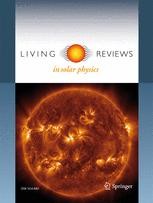Living Reviews in Solar Physics: "Solar prominences: theory and models"
 Gibson, S.E., Solar prominences: theory and models. Fleshing out the magnetic skeleton, Living Rev Sol Phys (2018) 15: 7. https://doi.org/10.1007/s41116-018-0016-2
Gibson, S.E., Solar prominences: theory and models. Fleshing out the magnetic skeleton, Living Rev Sol Phys (2018) 15: 7. https://doi.org/10.1007/s41116-018-0016-2
Open Access | Review Article
First Online: 22 October 2018
https://link.springer.com/article/10.1007/s41116-018-0013-5
"This is a nice and comprehensive paper about solar prominence magnetic fields, environment, and plasma. It reviews the whole topic, from the earliest paper, up to the new findings that were published since last coupled reviews on this topic (MacKay et al. and Labrosse et al. 2010, Space Sci Rev). This fully justifies to this new review, with its possibility to make regular updates through its `living' format. This review is quite pedagogical and most useful to the community."
Abstract:
Magnetic fields suspend the relatively cool material of solar prominences in an otherwise hot corona. A comprehensive understanding of solar prominences ultimately requires complex and dynamic models, constrained and validated by observations spanning the solar atmosphere. We obtain the core of this understanding from observations that give us information about the structure of the “magnetic skeleton” that supports and surrounds the prominence. Energetically-sophisticated magnetohydrodynamic simulations then add flesh and blood to the skeleton, demonstrating how a thermally varying plasma may pulse through to form the prominence, and how the plasma and magnetic fields dynamically interact.
The authors:
Sarah Gibson is a Senior Scientist in the High Altitude Observatory (HAO) at the National Center for Atmospheric Research, and Section Head of HAO’s Solar Frontiers Section. Her research centers on solar drivers of the terrestrial environment, from short-term space weather drivers such as coronal mass ejections (CMEs), to long-term solar cycle variation. She uses theoretical models to understand the magnetic origins of CMEs and related space weather phenomena.
